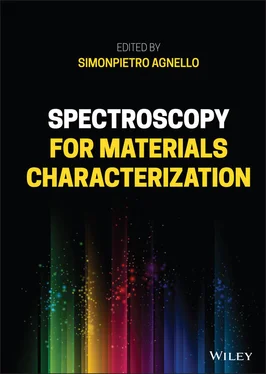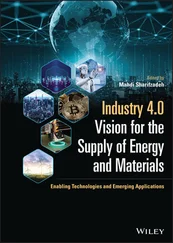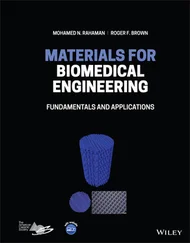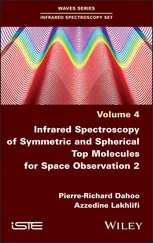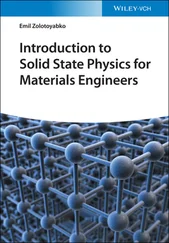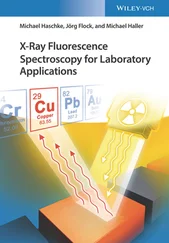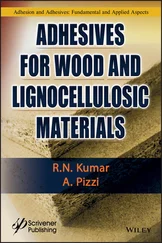Spectroscopy for Materials Characterization
Здесь есть возможность читать онлайн «Spectroscopy for Materials Characterization» — ознакомительный отрывок электронной книги совершенно бесплатно, а после прочтения отрывка купить полную версию. В некоторых случаях можно слушать аудио, скачать через торрент в формате fb2 и присутствует краткое содержание. Жанр: unrecognised, на английском языке. Описание произведения, (предисловие) а так же отзывы посетителей доступны на портале библиотеки ЛибКат.
- Название:Spectroscopy for Materials Characterization
- Автор:
- Жанр:
- Год:неизвестен
- ISBN:нет данных
- Рейтинг книги:5 / 5. Голосов: 1
-
Избранное:Добавить в избранное
- Отзывы:
-
Ваша оценка:
- 100
- 1
- 2
- 3
- 4
- 5
Spectroscopy for Materials Characterization: краткое содержание, описание и аннотация
Предлагаем к чтению аннотацию, описание, краткое содержание или предисловие (зависит от того, что написал сам автор книги «Spectroscopy for Materials Characterization»). Если вы не нашли необходимую информацию о книге — напишите в комментариях, мы постараемся отыскать её.
Learn foundational and advanced spectroscopy techniques from leading researchers in physics, chemistry, surface science, and nanoscience Spectroscopy for Materials Characterization,
Simonpietro Agnello
Spectroscopy for Materials Characterization
Spectroscopy for Materials Characterization — читать онлайн ознакомительный отрывок
Ниже представлен текст книги, разбитый по страницам. Система сохранения места последней прочитанной страницы, позволяет с удобством читать онлайн бесплатно книгу «Spectroscopy for Materials Characterization», без необходимости каждый раз заново искать на чём Вы остановились. Поставьте закладку, и сможете в любой момент перейти на страницу, на которой закончили чтение.
Интервал:
Закладка:
The first chapter is dedicated to the basic aspects of radiation–matter interaction in the visible‐ultraviolet range and the fundamentals of absorption and emission (fluorescence and phosphorescence) processes of atoms and molecules. This chapter is followed by two chapters on time‐resolved spectroscopy at the nanosecond scale and the more recent frontier approach of ultrafast spectroscopy at the femtosecond scale. These chapters detail the aspects of the electron dynamics in the excited states after pulsed excitation through emission and absorption processes including the Raman effect. Then, a chapter dedicated to fluorescence microscopy imaging at the nanoscale domain is presented with confocal and two‐photon techniques, where aspects of spatial resolution and dynamics are explored. The molecular vibrational spectroscopy in the infrared range is tackled in Chapters 5and 6by both the absorption and the Raman scattering effects. These chapters report on the fundamental aspects of radiation‐molecular vibration interaction and consider the traditional experimental methods, detailing the most recent applications of microscopy and joined vibrational–atomic force microscopy. The following two chapters consider spectroscopy related to irradiation effects. The first is focused on the thermoluminescence phenomenon of light emission induced by heating a sample after it has been exposed to ionizing radiation environment. The spectroscopic aspects are introduced and the basics of the phenomenon together with the interpretation of trap states and release thermodynamics are deepened in view of the application in many emerging fields such as dosimetry. In a similar context, Chapter 8reports on the phenomena of radiation‐induced absorption, emission, and compaction with a focus on the novel online (in situ) measurements, particularly useful for the spectroscopic study of the materials' modifications during their exposure to ionizing radiation as well as their recovery processes. Chapters 9and 10treat the magnetic spectroscopy illustrating the electron and nuclear phenomena. In particular, electron paramagnetic resonance in the static and dynamic domains are dealt with in the former chapter, considering hyperfine interaction, transient dynamics, and the S = 1 state paramagnetism. In the latter chapter, the standard as well as the non‐conventional nuclear magnetic resonance phenomena are introduced including the Fourier transform, the Magic Angle Spinning, and the time domain studies. The book then reports on high‐energy spectroscopy with three chapters on X‐rays and ultraviolet radiation. Chapter 11reports on the absorption process of X‐rays in near edge and pre‐edge, also including fine structure determination and in situ spectroscopy. Chapter 12 introduces photoelectron emission illustrating the surface maps and the depth and angle resolved profiles. Successively, Chapter 13covers vacuum ultraviolet excitations considering the most widely available sources. Finally, two structural spectroscopy chapters on transmission electron spectroscopy (TEM) and atomic force microscopy (AFM) are included. They report on the structural investigation at the atomic and nanometric scale including those spectroscopic aspects pertaining to high‐energy excitation in the former technique and to the novel interpretation of spectroscopy in the latter.
The book, as stated above, is the result of the contribution of different scientists mainly working in the field of physics, chemistry, surface science, and nanoscience. Their different points of view assure a multidisciplinary approach to the techniques and, as a consequence, appeal to a broad readership of researchers and students dedicated to the studies on materials.
The Editor Simonpietro Agnello
List of Contributors
Simonpietro Agnello Department of Physics and Chemistry – Emilio Segrè University of Palermo Palermo Italy
Raffaele Giuseppe Agostino Dipartimento di Fisica Università della Calabria Rende CS Italy
Antonino Alessi Fraunhofer Institute for Technological Trend AnalysisAppelsgarten 2 Euskirchen Germany Laboratoire des Solides IrradiésCEA/DRF/IRAMIS,CNRS, Ecole polytechnique Institut Polytechnique de Paris Palaiseau France
Gianpiero Buscarino Department of Physics and Chemistry – Emilio Segrè University of Palermo Palermo Italy
Marco Cannas Department of Physics and Chemistry – Emilio Segrè University of Palermo Palermo Italy
Pellegrino Conte Department of Agriculture,Food and Forestry Sciences University of Palermo Palermo Italy
Vincenzo De Michele Laboratoire Hubert Curien Université Jean Monnet Saint‐Etienne France
Giuliana Faggio Department of Information Engineering Infrastructure and Sustainable Energy University Mediterranea of Reggio Calabria Reggio Calabria Italy
Tiziana Fiore Department of Physics and Chemistry – Emilio Segrè University of Palermo Palermo Italy
Vincenzo Formoso Dipartimento di Fisica Università della Calabria Rende CS Italy
Franco Gelardi Department of Physics and Chemistry – Emilio Segrè University of Palermo Palermo Italy
Francesco Giannici Department of Physics and Chemistry – Emilio Segrè University of Palermo Palermo Italy
Sylvain Girard Laboratoire Hubert Curien Université Jean Monnet Saint‐Etienne France
Rossella Grillo Department of Information Engineering Infrastructure and Sustainable Energy University Mediterranea of Reggio Calabria Reggio Calabria Italy
Alessandro Longo The European Synchrotron Grenoble France ISMN‐CNR Palermo Italy
Fabrizio Messina Department of Physics and Chemistry – Emilio Segrè University of Palermo Palermo Italy
Giacomo Messina Department of Information Engineering Infrastructure and Sustainable Energy University Mediterranea of Reggio Calabria Reggio Calabria Italy
Adriana Morana Laboratoire Hubert Curien Université Jean Monnet Saint‐Etienne France
Federico Moretti Lawrence Berkeley National Laboratory Berkeley CA USA
Claudia Pellerito Department of Physics and Chemistry – Emilio Segrè University of Palermo Palermo Italy
Christoph J. Sahle The European Synchrotron Grenoble France
Giuseppe Sancataldo Department of Physics and Chemistry – Emilio Segrè University of Palermo Palermo Italy
Alice Sciortino Department of Physics and Chemistry – Emilio Segrè University of Palermo Palermo Italy
Michelangelo Scopelliti Department of Physics and Chemistry – Emilio Segrè University of Palermo Palermo Italy
Alberto Spinella Advanced Technologies Network Center (ATeN Center) University of Palermo Palermo Italy
Lavinia Vaccaro Department of Physics and Chemistry – Emilio Segrè University of Palermo Palermo Italy
Valeria Vetri Department of Physics and Chemistry – Emilio Segrè University of Palermo Palermo Italy
Anatoly F. Zatsepin Russian Academy of SciencesUral DivisionYekaterinburgRussia Institute of Physics and TechnologyUral Federal UniversityYekaterinburgRussia
Dmitry A. Zatsepin Russian Academy of SciencesUral DivisionYekaterinburgRussia Institute of Physics and TechnologyUral Federal UniversityYekaterinburgRussia
1 Radiation–Matter Interaction Principles: Optical Absorption and Emission in the Visible‐Ultraviolet Region
Simonpietro Agnello
Department of Physics and Chemistry – Emilio Segrè, University of Palermo, Palermo, Italy
1.1 Empirical Aspects of Radiation–Matter Interaction
The basic everyday experience of the colors around us inspires the knowledge of the phenomenon of radiation–matter interaction. Sun, the source of daylight, emits a large quantity of electromagnetic field frequencies ( ν ), or wavelengths ( λ ). When these rays impinge on matter, they can be reflected (scattered) or absorbed by the constituent atoms and molecules. These phenomena give rise to the appearance of colored objects since the light arriving at our eyes (a light sensor) depends on the emitted radiation or the reflected one, having fewer frequencies than the original sunlight due to the absorption effect of matter around us. In this chapter, some empirical aspects of absorption and emission phenomena will be introduced.
Читать дальшеИнтервал:
Закладка:
Похожие книги на «Spectroscopy for Materials Characterization»
Представляем Вашему вниманию похожие книги на «Spectroscopy for Materials Characterization» списком для выбора. Мы отобрали схожую по названию и смыслу литературу в надежде предоставить читателям больше вариантов отыскать новые, интересные, ещё непрочитанные произведения.
Обсуждение, отзывы о книге «Spectroscopy for Materials Characterization» и просто собственные мнения читателей. Оставьте ваши комментарии, напишите, что Вы думаете о произведении, его смысле или главных героях. Укажите что конкретно понравилось, а что нет, и почему Вы так считаете.
